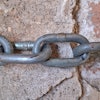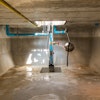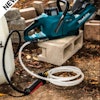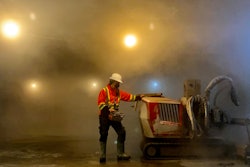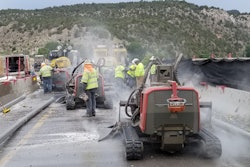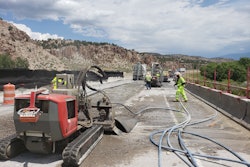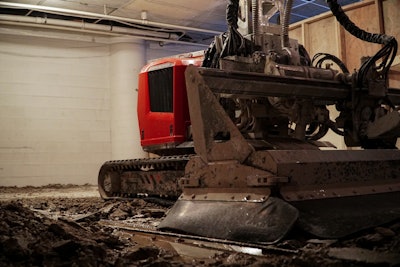
Job Stats
Location: Cincinnati
Dates: February 2018 – Late January 2019
Duration: 10-14 months
Equipment: 1 Aquajet Aqua Cutter 710 Hydrodemolition Robot, 4 Handheld Breakers, 1 Bobcat Skid Steer, 1 Dingo and 1 PAM OVE
Panoramic views of the Ohio River from 25 stories up. To the west? Bird’s-eye perspective of peaceful Eden Park. Beyond that, beautiful downtown Cincinnati. A rare placid scene in the heart of the bustling city of 300,000. It seems nothing could blemish the setting for the residents of one of Cincinnati’s sought-after luxury condos.
Except, perhaps, the clatter of 20-odd handheld breakers. Such was the concern of a luxury condo complex when it became necessary to renovate the high-rise’s deteriorating parking garage. The project would require extensive removal of damaged concrete, work traditionally accomplished by handheld pneumatic tools. Renovations such as this have developed a negative reputation for bombarding surrounding neighborhoods with dust, noise and extensive disruptions.
Because the complex is an active building, the appointed contractor would be challenged with completing the renovation on time and budget while minimizing common construction disturbances, such as dust and noise. Additionally, the contractor would need to find innovative ways to manage potential interruptions to accommodate the active parking garage, as well as skillfully navigate complex phasing to allow residents to continue using the garage during construction. A tall order, even for an experienced contractor.
The complex selected Structural Systems Repair Group (SSRG) as the general contractor. SSRG is a Cincinnati-based contracting company that specializes in the repair, restoration and modification of existing buildings. They have established a positive reputation in highly technical structural applications, including historic preservation and facility upgrades and modifications.
“SSRG started because of a growing need for building rehabilitation,” says Brad Rogers, SSRG vice president. “The beauty of what we do is there are always existing buildings in need of modification or repair and each with unique challenges. Our experience in this type of work helps us find creative solutions to these challenges.”
The project began in February 2018 with concrete repairs finishing up at the end of January 2019. To ensure their portion of the project was completed on time, SSRG carefully developed a 10-phase repair approach using hydrodemolition to maximize efficiency, while allowing tenants to continue to use the parking garage. This quick rehabilitation schedule left little time for downtime and inefficiency.
High-Tech Solutions
After fully assessing the parking structure, SSRG discovered a sizable amount of deferred maintenance that needed to be addressed, adding to an already ambitious renovation. SSRG estimated 480 cubic yards of repairs spanning 30,000 square feet of surface area were needed, with certain levels of the structure requiring over 60% replacement. To complete the project on time, the contractor needed to implement a highly efficient technique—hydrodemolition. 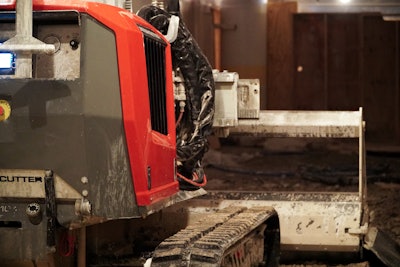 SSRG utilized a crew of six for a job that would traditionally have taken 30 workers.
SSRG utilized a crew of six for a job that would traditionally have taken 30 workers.
"There was not just a little damage here and there; the scale of this project was huge,” Rogers says. “The extent of the damage in combination with it being an active building drove our choice to use hydrodemolition. It’s cleaner, quicker and less noisy than traditional methods.”
The contractor purchased an Aqua Cutter 710 hydrodemolition robot from Aquajet Systems AB in January 2017. The machine uses high-pressure water to remove damaged and deteriorating concrete while allowing the operator to maneuver the machine remotely—out of harm’s way. Representatives from Aquajet Systems trained SSRG employees on the machine before their first hydrodemolition job.
An Uphill Battle
Before work could begin, SSRG had to plan project phasing to ensure the garage remained functional for the tenants throughout the renovation. This proved a challenge due to the garage’s unique design. The 5-story parking garage sat at the base of the high-rise apartment building and was engineered to account for the steep hill on which it was built. It rested at-grade on the north side and at walkout level on the other.
Additionally, given the delamination of the concrete structure, the project required extensive shoring, resulting in installation of more than 800 shoring posts. The contractor worked from a global grid, gridding the entire floor instead of just localized beams to ensure the structure was supported appropriately. Workers also installed hard barriers composed of plywood walls and plastic to separate working zones from occupied space to ensure residents—and their vehicles—remained unaffected.
After beginning the concrete removal process, SSRG found surprising new efficiencies with their hydrodemolition robot.
“Especially for residential projects, we are typically faced with a large amount of noise issues with existing tenants,” Rogers says. “The Aqua Cutter operates so quietly, however, our team received very few noise concerns, but rather multiple compliments about the minimal noise coming from the jobsite.”
A job of this magnitude would typically have demanded 15-20 handheld breakers, resulting in a high-decibel disturbance roughly equivalent to the sound of a music festival.
The operator directed the Aqua Cutter, jetting water at 15,000 psi, to remove the damaged concrete to varying depths. This ranged from 4 inches to full depth, depending on the level of deterioration. In total, the robot removed about 480 cubic yards of concrete, jetting about 24,000 gallons of water per 10-hour shift.
“In terms of precision, the hydrodemolition machine is the same as having a very skilled operator on a jackhammer,” Rogers says. “We’re able to set the robot so it removes only the weaker concrete, leaving the sound concrete intact.” 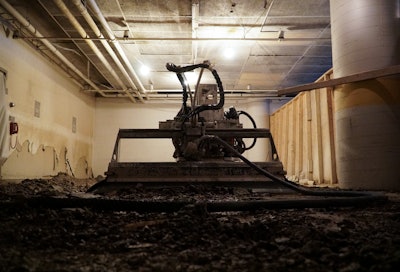 SSRG removed about 400 cubic yards of concrete with the Aqua Cutter 710.
SSRG removed about 400 cubic yards of concrete with the Aqua Cutter 710.
Workers built barricades to contain water and debris as the robot removed concrete. They routed the water across each level of the garage and through a series of filters, allowing gravity to help with debris removal. By the time the water reached the lowest level, most of the slurry had already been removed. SSRG then pooled the water to ensure it met the standards of the Metropolitan Sewer District of Greater Cincinnati. From there, SSRG pumped the water safely into the city’s sewer system.
SSRG was able to greatly reduce the labor needed for the concrete removal work. The company’s traditional methods would have required upward of 30 workers, but SSRG needed only a crew of six with the aid of the hydrodemolition machine. Two operators manned the robot while four workers handled water control, edge detail work and removal of material as the Aqua Cutter worked its way through the jobsite. The robot was fed high-pressure water by a Hammelmann power pack.
The hydrodemolition robot handled the bulk of the concrete removal, but pneumatic breakers were still used for detail work. SSRG used a PAM OVE positioning device manufactured by RNP Industries for overhead demolition. The combination of the hydrodemolition robot and overhead chipping equipment spared workers from bearing the physical strains of long periods of handheld breaker operation.
Efficient to the Finish
SSRG managed the complicated parking garage renovation with nearly 25 fewer workers than typical for a job of this magnitude. At the same time, the contractor virtually eliminated disturbance to the building’s residents, while staying on track to its deadline.
These efficiencies added up to significant cost savings for the contractor and the owner. SSRG saved over 10,000 manhours on the job versus conventional methods.
But labor cost savings only tell part of the story. Because hydrodemolition is an impact-free process, it virtually eliminates microfractures and damage to existing rebar, common and costly side effects of using breakers for concrete removal. SSRG avoided frustrating delays and expensive downtime caused by unnecessary damage to good concrete.
SSRG dealt with an estimated total surface area of 30,000 square feet and removed 480 cubic yards of damaged concrete, a complex job that required a multifaceted strategy to finish by deadline. The company exceeded expectations on a challenging renovation with careful planning, sophisticated equipment and innovating thinking. Thanks to the quality and efficiency of its work on the complex renovation, SSRG can look forward to happy customers, greater profits and a deserved reputation as concrete demolition innovators in Cincinnati.
Editor's Note: This article was contributed by Aquajet.
